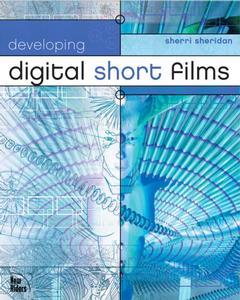Developping digital short films (with CD-ROM)
Langue : Anglais
Auteur : SHERIDAN Sherri

From idea-generation to production planning, this is THE book digital filmmakers and animators need!
- Offers step-by-step advice for anyone who has a desire to tell a story, think one up and execute it visually.
- Expands the use of existing desktop technology for cinematography, editing, sound and production styles.
- The author is both a practitioner and an educator.
Introduction.
Getting the Most Out of This Book. Becoming a Better Digital Filmmaker. Do Not Let Anything Stop You from Making Your Film. I. DIGITAL STORYTELLING.
1. Generating Ideas for Digital Short Films.
Beginning the Story Concept Process. Character. Plot. Theme. Using Digital Tools to Create Original Films. Generating Original Ideas for Digital Short Films. Brainstorming for Software Capabilities. Incorporating Plot Goals. Final Story Concept Sentence to Pitch. Final Story Idea.
2. Creating Original Characters, Themes, and Visual Metaphors.
Creating Powerfully Original Characters. Developing Themes In Films. Using Metaphors and Symbols to Tell Stories.
3. Developing Plot Points.
Aristotelian Dramas. Creating Character Arcs. Short Film Plot Points. Plot Points for Feature Films. Writing a Short Treatment.
4. Writing Scenes, Conflict, and a Short Script.
The Joy of Index Cards. Three-Act Structure for Developing Scenes. Constructing Individual Scenes. Moving the Story Forward Through Conflict. Adding Subtext to Scenes. Writing Dialogue. Writing a Short Script. II. VISUALIZING YOUR SCRIPT.
5. Shot Visualization.
Producing the Final Storyboards. Determining the Organizational Structure. 101 Camera Shots for Storyboarding. Designing Camera Shots. Sketching Rough Overheads. Composing Your Shots. Creating Depth in Your Camera Shots. Creating Storyboards.
6. Mise En Sc ne for the Twenty-First Century.
Developing Visual Styles. Developing Digital Production Styles. Creating Visually Expressive Characters. Developing Set Designs. Conceptual Lighting Design. Developing a Color Palette.
7. Narrative Sound Design.
The Importance of Good Sound. Viewing-Room Speakers. Sound in the Script. Breaking Down Your Scripts for Sound. Creating a Sound Ambiance for Each Scene. Utilizing Different Sound Sources. Creating Original Sound Effects. Utilizing Offscreen Sound. Creating Sound Space for the Audience. Sound as POV. Designing Dialogue Styles. Matching Sound to Camera Shots. Mindspace Sound Design. Shooting Without Sound. Sound Problems.
8. Preproduction Story-Editing Choices.
Editing Information Is Natural to Storytelling. Juxtaposition as the Core of Editing. Print Out a Still of Each Shot. Miscellaneous Editing Tips. Final Thoughts on Nonlinear Editing. III. CREATING DIGITAL SHORT FILMS FOR DIFFERENT PRODUCTION STYLES.

Disney StoriesGetting to Digital 49,57 €

Maya Manual 52,74 €
9. Digitally Enhanced Storytelling Techniques.
Using Digital Video Techniques to Tell Visual Stories. What Are Some Advantages of Using DV to Tell Stories? How to Combine Layers Using Transparent Areas. Creating Camera Shots Digitally in Post. Animating Still Photographs with Video Layers. DV Character Design Ideas. Digitally Enhanced Character Design Techniques. Creating Virtual Sets. Using Text and Motion Graphics to Tell a Story. Creating Simple Narrative Digital Effects. Defining a Visual Style for Your Film. Adding a 2D Animated Look to DV Footage. Using Color Manipulation to Develop Narrative Ideas. Other Digital Techniques.
10. Using Modern 2D Animation to Expand Our Realities.
Advantages of Visual Storytelling with 2D Animation. The Principles of Animation. Modern 2D Animated Design Ideas. Simple 2D Digital Animation Techniques. Defining Your Own 2D Style of Animation.
11. Using 3D Animation to Show Anything You Can Imagine.
Some Good Narrative Uses for 3D. Brainstorming for 3D Story Ideas. Designing Original 3D Characters. Utilizing Visual Motifs. Attaching an Actor to Your 3D Character. Designing Original 3D Sets. Creating Your Own 3D Animation Style.
Index.
Date de parution : 06-2004
Ouvrage de 400 p.
25.4x20.3 cm
Thème de Developping digital short films (with CD-ROM) :
© 2024 LAVOISIER S.A.S.
Ces ouvrages sont susceptibles de vous intéresser

Disney StoriesGetting to Digital 49,57 €

Maya Manual 52,74 €
